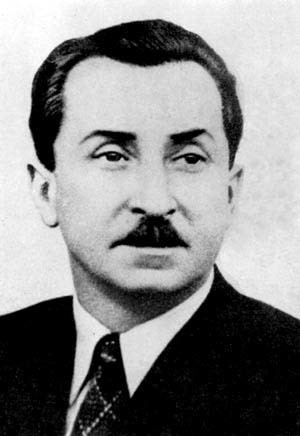Name Pavlo Virsky | Role Dancer | |
 | ||
Died June 5, 1975, Kiev, Ukraine Awards Shevchenko National Prize in Concert-Performing Art and Spoken Word | ||
Virsky hopak ukrainian dance
Pavlo Pavlovych Virsky (Ukrainian: Павло Павлович Вірський) (1905–1975) was a dancer, balletmaster, choreographer, and founder of the P. Virsky Ukrainian National Folk Dance Ensemble, whose work in Ukrainian dance was groundbreaking and influenced generations of dancers.
Contents

Moraki pavlo virsky
Early days
Pavlo Virsky was born on February 25, 1905 in Odessa, Russian Empire. After graduating from the Odessa Music and Drama School in 1927, he continued his studies in Moscow, at the Theater Technicum, from 1927-28. Beginning in 1925, state theaters began to be organized throughout the Ukrainian SSR, allowing for gainful employment for artists, and upon his return to Odessa in 1928, Virsky joined the Odesa Opera and Ballet Theatre as a dancer and choreographer. It was at this theater that he collaborated with Mykola Bolotov in their first joint production: Gliere's The Red Poppy. Virsky left the Odessa in 1931, and worked as a balletmaster at various theatres, including those in Kharkiv, Dnipropetrovsk, and Kiev, working on productions of ballets such as Raymonda, La Esmeralda, Le Corsaire, Swan Lake, and Don Quixote.
Folk dance
The Kiev Opera and Ballet brought two productions to Moscow in 1936 as part of the first festival of Ukrainian Literature and Art: Mykola Lysenko's opera Natalka Poltavka, and Semen Hulak-Artemovsky's opera Zaporozhets za Dunayem (A Zaporizhian [Kozak] Beyond the Danube), the latter which included choreographed Ukrainian folk dances by Pavlo Virsky and Mykola Bolotov. The following year, Virsky and Bolotov founded the State Folk Dance Ensemble of the Ukrainian SSR, with which they developed an entire program of staged Ukrainian folk dances. With the outbreak World War II, and in the build-up to the Great Patriotic War, many ensembles suspended activity, as performers were enlisted to entertain the troops. Virsky continued his work with folk-themed choreography as the director of the Red Flag Song and Dance Ensemble of the Kiev Military District beginning in 1939. In 1942, he left as that ensemble, and became the artistic director of the Red Army Song and Dance Ensemble dancers, and remained in that post for many years.
In 1955, Virsky returned to Kiev to helm the State Folk Dance Ensemble of the Ukrainian SSR he founded, which had been reconstituted by others after the conclusion of the war. For the next 20 years (until his death in 1975) Pavlo Virsky developed the concepts of Ukrainian folk-stage dance further than had previously been imagined. He founded a school to train dancers in the technique he developed. He toured the world with his dancers, influencing Ukrainian dancers the world over.
Virsky died on July 5, 1975 in Kiev. The State Folk Dance Ensemble of the Ukrainian SSR was named after him in 1977.
